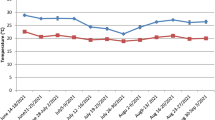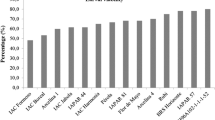Abstract
Cowpea [Vigna unguiculata (L.) Walp] seeds are an important source of nutrients for human and animal. However, part of the seed production is lost due to insect attacks, mainly by the weevil Callosobruchus maculatus (F.) (Coleoptera: Chrysomelidae), a major pest of stored cowpeas. An efficient method for controlling seed infestation is the use of insect-resistant cultivars. In this work, we studied the resistance of different cowpea Brazilian cultivars (BRS) to infestation and damage by C. maculatus. Our results showed that some cultivars interfered in female oviposition. The time necessary for the larvae to perforate the seed coat of some cultivars increased up to 40 %. No relationship between seed coat thickness, textures, or pigmentation and the larval ability of crossing seed coats was observed. Larval survival was also affected by cowpea cultivars. In BRS Xiquexique, only 30 % of the larvae survived at 20 days after oviposition. The weight of larvae developed into BRS Pajeu, and BRS Xiquexique cultivars decreased about 50 %. Cysteine protease, α-glucosidase, and α-amylase activities decreased in larvae developed in some cultivars, mainly in Pajeu, Guariba, Tucumaque, and Xiquexique. Adult emergence also decreased in Xiquexique, Pajeu, Tucumaque, and Paraguaçu BRS cultivars. A direct relationship between higher infestation and lower seed germination and seedling growth potential was observed. From these data, we would recommend the use of Pajeu, Guariba, Tucumaque, and Xiquexique BRS cultivars as a way to reduce cowpea infestation, and suggest that their resistance mechanism is related to the diminishment of larval digestive abilities.







Similar content being viewed by others
References
Aguiar JM, Franco OL, Rigden DJ, Bloch C Jr, Monteiro AC, Flores VM, Jacinto T, Xavier-Filho J, Oliveira AE, Grossi-de-Sá MF, Fernandes KV (2006) Molecular modeling and inhibitory activity of cowpea cystatin against bean bruchid pests. Proteins 15:662–670
Appleby JA, Credland PF (2003) Variation in responses to susceptible and resistant cowpeas among West African populations of Callosobruchus maculatus (Coleoptera: Bruchidae). J Econ Entomol 96:489–502
Badii BK, Adarkwah C, Obeng-Ofori D, Ulrichs C (2014) Efficacy of diatomaceous earth formulations against Callosobruchus maculatus (F.) (Coleoptera: Bruchidae) in Kersting’s groundnut (Macrotyloma geocarpum Harms): influence of dosage rate and relative humidity. J Pest Sci 87:285–294
Bae SD, Kim HJ, Mainali BP (2014) Changes in nutritional composition of soybean seed caused by feeding of pentatomid (Hemiptera: Pentatomidae) and alydid bugs (Hemiptera: Alydidae). J Econ Entomol 107:1055–1060
Beck CW, Blumer LS (2007) A handbook on bean beetles, Callosobruchus maculatus. http://www.beanbeetles.org
Bewley JD (1997) Seed germination and dormancy. Plant Cell 9:1055–1066
Boughdad A, Gillon Y, Gagnepain C (1986) Influence du tegument des graines mures de Vicia faba sur le developpement larvaire de Callosobruchus maculates. Entomol Exp Appl 42:219–223
Bridge PD, Sawilowsky SS (1999) Increasing physicians’ awareness of the impact of statistics on research outcomes: comparative power of the t-test and and Wilcoxon Rank-Sum test in small samples applied research. J Clin Epidemiol 52:229–235
Carlini CR, Grossi-de-Sá MF (2002) Plant toxic proteins with insecticidal properties. A review on their potentialities as bioinsecticides. Toxicon 40:1515–1539
Chi YH, Salzman RA, Balfe S, Ahn JE, Sun W, Moon J, Yun DJ, Lee SY, Higgins TJ, Pittendrigh B, Murdock LL, Zhu-Salzman K (2009) Cowpea bruchid midgut transcriptome response to a soybean cystatin—costs and benefits of counter-defence. Insect Mol Biol 18:97–110
Crawley MJ (2000) Seed predators and plant population dynamics. In: Fenner M (ed) Seeds: the ecology of regeneration in plant communities. CAB International, Wallingford, pp 167–181
Credland PF (1987) Effects of host change on the fecundity and development of an unusual strain of Callosobruchus maculatus (F.) (Coleoptera: Bruchidae). J Stored Prod Res 23:91–98
De Sá LFR, Wermelinger TT, Ribeiro ES, Gravina GA, Fernandes KVS, Xavier-Filho J, Venancio TM, Rezende GL, Oliveira AEA (2014) Effects of Phaseolus vulgaris (Fabaceae) seed coat on the embryonic and larval development of the cowpea weevil Callosobruchus maculatus (Coleoptera: Bruchidae). J Insect Physiol 60:50–57
Desroches P, El Shazly E, Mandon N, Duc G, Huignard J (1995) Development of Callosobruchus chinensis (L.) and Callosobruchus maculatus (F.) (Coleoptera: Bruchidae) in seeds of Vicia faba L. differing in their tannin, vicine and convicine contents. J Stored Prod Res 31:83–89
Dick K, Credland PF (1986) Changes in the response of Callosobruchus maculatus (Coleoptera: Bruchidae) to a resistant variety of cowpea. J Stored Prod Res 22:221–233
Gatehouse AMR, Gatehouse JA, Dobie P, Kilminster AM, Boulter D (1979) Biochemical basis of insect resistance in Vigna unguiculata. J Sci Food Agric 30:948–958
Hall AE, Cisseb N, Thiawb S, Elawadc HOA, Ehlersa JD, Ismaild AM, Ferye RL, Robertsf PA, Kitchg LW, Murdockh LL, Boukari O, Phillipsj RD, McWattersj KH (2003) Development of cowpea cultivars and germplasm by the Bean/Cowpea CRSP. Field Crop Res 82:103–134
Ishimoto M, Kitamura K (1989) Growth inhibitory effects of alpha amylase inhibitor from the kidney bean, Phaseolus vulgaris (L) on 3 species of bruchids (Coleoptera, Bruchididae). Appl Entomol Zool 24:281–286
Jackai LEN, Asante SK (2003) A case for the standardization of protocols used in screening cowpea, Vigna unguiculata for resistance to Callosobruchus maculatus (Fabricius) (Coleoptera: Bruchidae). J Stored Prod Res 39:251–263
Janzen DH (1977) How southern cowpea weevil larvae (Callosobruchus maculatus) die on non-host seeds. Ecology 58:921–927
Lale NES, Efeovbokhan SO (1991) Resistance status of new cowpea cultivars to a storage insect pest, Callosobruchus maculatus. Postharvest Biol Technol 1:181–186
Macedo MLR, Andrade LBS, Moraes RA, Xavier-Filho J (1993) Vicilin variants and the resistance of cowpea (Vigna unguiculata) seeds to the cowpea weevil (Callosobruchus maculatus). Comp Biochem Physiol 105:88–94
Macedo MLR, Fernandes KVS, Sales MP, Xavier-Filho J (1995) Purification and properties of storage proteins (vicilins) from cowpea (Vigna unguiculata) seeds which are susceptible or resistant to the bruchid beetle Callosobruchus maculatus. Braz J Med Biol Res 28:183–190
Michaud D, Nguyen-Quoc B, Bernier-Vadnais N, Faye L, Yelle S (1994) Cysteine proteinase forms in sprouting potato tuber. Plant Physiol 90:497–503
Miller GL (1959) Use of dinitrosalicylic acid reagent for determination of reducing sugar. Anal Chem 31:426–428
Moïse JA, Han S, Gudynaitę-Savitch L, Johnson DA, Mikica BLA (2005) Seed coats: structure, development, composition, and biotechnology. In Vitro Cell Dev Biol Plant 41:620–644
Nangju D, Flinn JC, Singh SR (1979) Control of cowpea pests by utilization of insect-resistant cultivars and minimum insecticide application. Field Crop Res 2:373–385
Nogueira FCS, Silva CP, Alexandre D, Samuels RI, Soares EL, Aragão FJ, Palmisano G, Domont GB, Roepstorff P, Campos FA (2012) Global proteome changes in larvae of Callosobruchus maculatus (Coleoptera: Chrysomelidae: Bruchinae) following ingestion of a cysteine proteinase inhibitor. Proteomics 00:1–12
Oliveira AEA, Fernandes KVS, Souza AJ, Santos PO (2009) Influence of the soybean seed coat upon seed infestation and development of Callosobruchus maculatus larvae (in press). In: Soybean and Wheat Crops: Growth, Fertilization, and Yield: Soybean crops: growth, fertilization and yield. Nova Science Publishers, New York, pp 335–372
Pedra JHF, Brandt A, Westerman R, Lobo N, Li HM, Romero-Severson J, Murdock LL, Pittendrigh BR (2003) Transcriptome analysis of the cowpea weevil bruchid: identification of putative proteinases and alpha-amylases associated with food breakdown. Insect Mol Biol 12:405–412
Phillips RD, McWatters KH, Chinnan MS, Hung Y, Beuchat LR, Sefa-Dedeh S, Sakyi-Dawson E, Ngoddy P, Nnanyelugo D, Enwere J, Komey NS, Liu K, Mensa-Wilmot Y, Nnanna IA, Okeke C, Prinyawiwatkul W, Saalia FK (2003) Utilization of cowpeas for human food. Field Crop Res 82:193–213
Pueyo JJ, Morgan TD, Ameenuddin N, Liang C, Reeck GR, Chrispeels MJ, Kramer KJ (1995) Effects of bean and wheat alpha-amylase inhibitors on alpha-amylase activity and growth of stored-product insect pests. Entomol Exp Appl 75:237–244
Razmjou J, Naseri B, Hemati AS (2014) Comparative performance of the cotton bollworm, Helicoverpa armigera (Hubner) (Lepidoptera: Noctuidae) on various host plants. J Pest Sci 87:29–37
Ryan CA (1991) Protease inhibitor in plants: genes for improving defenses against insects and pathogens. Annu Rev Phytopathol 28:425–449
Sales MP, Macedo MRL, Xavier-Filho J (1992) Digestibility of cowpea (Vigna unguiculata) vicilins by pepsin, papain and bruchid midgut proteinases. Comp Biochem Physiol 103:945–950
Sales MP, Pimenta PP, Paes NS, Grossi-de-Sá MF, Xavier-Filho J (2001) Vicilins (7S storage globulins) of cowpea (Vigna unguiculata) seeds bind to chitinous structures of the midgut of Callosobruchus maculatus (Coleoptera: Bruchidae) larvae. Braz J Med Biol Res 34:27–34
Sales MP, Andrade LBS, Ary MB, Miranda MRA, Teixeira FM, Oliveira AS, Fernandes KVS, Xavier-Filho J (2005) Performance of bean bruchids Callosobruchus maculatus and Zabrotes subfasciatus (Coleoptera: Bruchidae) reared on resistant (IT81D-1045) and susceptible (Epace10) Vigna unguiculata seeds: Relationship with trypsin inhibitor and vicilin excretion. Comp Biochem Physiol 142:422–426
Seck D (1993) Resistance to Callosobruchus maculatus F. (Col., Bruchidae) in some cowpea varieties from Senegal. J Stored Prod Res 29:49–52
Singh BB (1999) Improved breeding lines with resistance to bruchid. IITA Annu Rep 11:29–30
Singh BB, Adjadi O, Singh SR (1985) Bruchid resistance in cowpea. Crop Sci 25:736–739
Singh BB, Ajeigbe HA, Tarawali SA, Fernandez-Rivera S, Abubakar M (2003) Improving the production and utilization of cowpea as food and fodder. Field Crop Res 84:169–177
Smith CM, Clement SL (2012) Molecular bases of plant resistance to arthropods. Annu Rev Entomol 57:309–328
Solleti SK, Bakshi S, Purkayastha J, Panda SK, Sahoo L (2008) Transgenic cowpea (Vigna unguiculata) seeds expressing a bean alpha-amylase inhibitor 1 confer resistance to storage pests, bruchid beetles. Plant Cell Rep 27:1841–1850
Souza AJ, Santos PO, Pinto MST, Wermelinger TT, Ribeiro ES, Souza SC, Deus MF, Souza MC, Xavier-Filho J, Fernandes KVS, Oliveira AEA (2011) Natural seed coats provide protection against penetration by Callosobruchus maculatus (Coleoptera: Bruchidae) larvae. Crop Prot 30:651–657
Terra WR, Ferreira C, De Bianchi AG (1979) Distribution of digestive enzymes among the endo and ectoperitrophic spaces and midgut cells of Rhynchosciara and its physiological significance. J Insect Physiol 25:423–434
Thiéry D (1984) Hardness of some fabaceous seed coats in relation to larval penetration by Acanthoscelides obtectus (Say) (Coleoptera: Bruchidae). J Stored Prod Res 20:177–181
Thiéry D, Jarry M, Pouzat J (1994) To penetrate or not penetrate? A behavioral choice by bean beetle first-instar larvae in response to Phaseolus vulgaris seed surface quality. J Chem Ecol 20:1867–1875
Vallejo-Marin M, Dominguez CA, Dirzo R (2006) Simulated seed predation reveals a variety of germination responses of neotropical rain forest species. Am J Bot 93:369–376
Acknowledgments
We would like to thank Dr. Francisco R. Freire-Filho (Programa de Melhoramento de Feijão-caupi da Embrapa Meio-Norte, Brazil) for kindly providing the cowpea cultivars used in this work. This work was supported by grants from the Brazilian agencies: FAPERJ, CNPq, CAPES, TECNORTE, and from the Universidade Estadual do Norte Fluminense Darcy Ribeiro.
Author information
Authors and Affiliations
Corresponding authors
Additional information
Communicated by C. G. Athanassiou.
Luana P. Cruz and Leonardo F. R. de Sá contributed equally to the execution of this work.
Rights and permissions
About this article
Cite this article
Cruz, L.P., de Sá, L.F.R., Santos, L.A. et al. Evaluation of resistance in different cowpea cultivars to Callosobruchus maculatus infestation. J Pest Sci 89, 117–128 (2016). https://doi.org/10.1007/s10340-015-0657-z
Received:
Revised:
Accepted:
Published:
Issue Date:
DOI: https://doi.org/10.1007/s10340-015-0657-z




